AOC i2353Ph - IPS for a nice, low price
by Chris Heinonen on January 30, 2012 12:40 AM ESTCalibration and Results
Of course, once we use ColorEyes Display Pro to calibrate the AOC, we would expect even better results than we got out of the box. As usual, we set a white point target of D65, a gamma of 2.2, minimum black level, and a white level of 200 nits. I then checked the quality of the calibration using the Gretag Macbeth color checker chart. Often you will see display reviews that use the calibration target points to see the quality of the calibration. That gives you a good indicator of how well the software and hardware was able to hit those targets, but unfortunately no idea if only those targets improved, or if other colors were improved as well. Using the Gretag Macbeth swatches, which are designed to mimic common colors in the real world, gives you a better idea of the overall quality of the calibration instead of the quality of those specific targets.
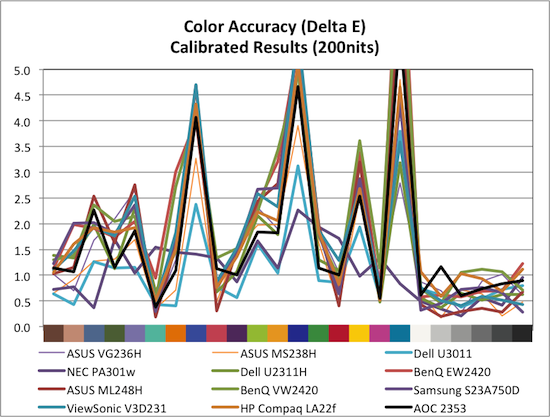
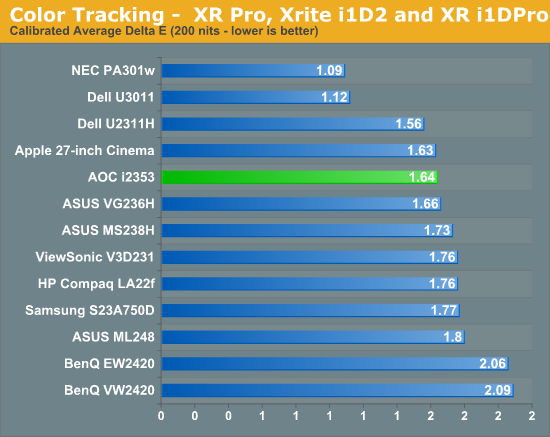
Here we see that the AOC calibrated down to an average dE of 1.64, which is pretty common. When I looked at the results some more, I got a little curious and also decided to see what the median color error was for all the displays. The Gretag Macbeth color checker includes some shades of blue that are at the very edge of the sRGB colorspace, or totally out of it in the case of one sample. In these cases if the display can’t reproduce those shades, the average dE for it might be thrown way off, but the median dE could still be very low since it does a very good job with the colors it can reproduce.
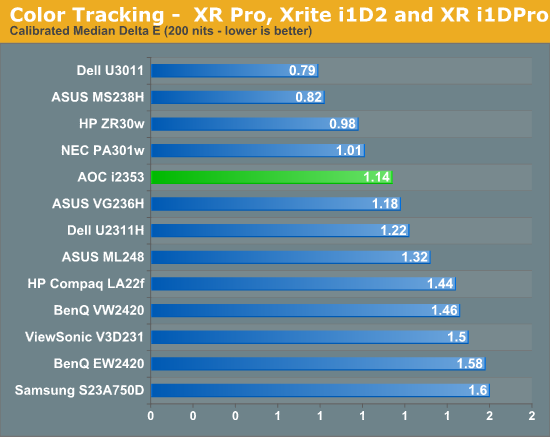
Looking at the results, we can see that the AOC has a much lower median dE than some monitors that produce a lower average dE. When we get to the color gamut data later in the review, we will see that the AOC has a smaller than average gamut, which is leading it to have larger than average errors for color samples on the edge of the sRGB colorspace. In effect, the conclusion we can pull from this is that the AOC can’t produce as many colors as other reviewed displays, but for those that it can produce it does so more accurately. Results like this are why you can’t just look at a lower dE and assume that a display will automatically be better than another display with a higher dE, as it’s just a single number that only tells part of the story.
For people that might use the AOC for press work, or prefer a dimmer display in a dark room like myself, I also calibrated the display to 100 nits of brightness and then took another set of readings.
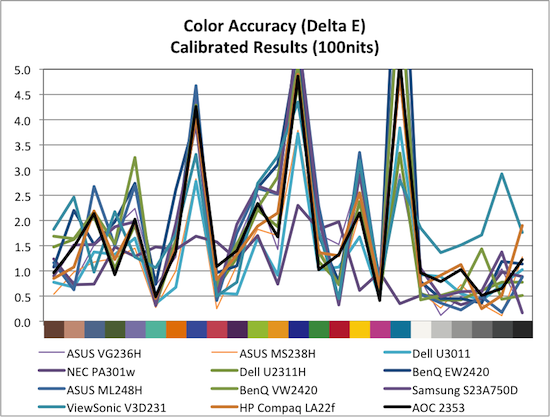
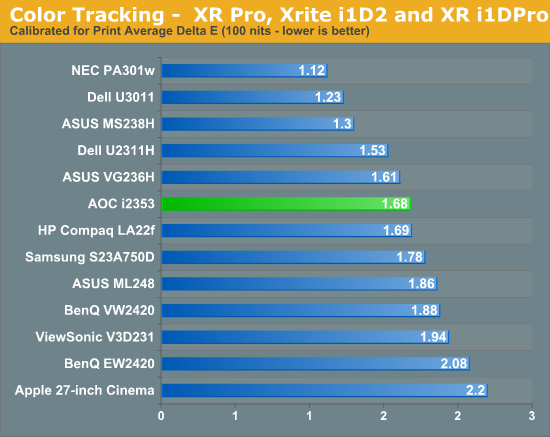
The numbers for 100 nits are almost identical to those for 200 nits. The grayscale is good, and the large errors are all contained in shades of blue, as we would expect.










71 Comments
View All Comments
cheinonen - Monday, January 30, 2012 - link
Not sure why that chart imported incorrectly, but it has been fixed. Thanks!baba264 - Monday, January 30, 2012 - link
I've recently changed to an IPS panel as well (HP ZR2440w) and the difference in gaming image quality has been impressive, especially in Batman Arkham City.jabber - Monday, January 30, 2012 - link
As I wanted to see how the new low cost IPS panels fared. I have to say I really like it. Looks as good as if not better than my Samsung PVA panel and as a work monitor its really good.Calibration was pretty much spot on out of the box. All I had to do was turn down the brightness a bit.
Definitely a nicer alternative at the cheaper end over TN.
Pino - Monday, January 30, 2012 - link
Who is the panel supplier?Does this AOC monitor use the same LG e-IPS panel found on the Dell and LG 23" e-IPS monitors?
Just bought myself a LG IPS236V:
http://www.lg.com/us/computer-products/monitors/LG...
Sabresiberian - Monday, January 30, 2012 - link
Panel manufacturer is LG:http://www.tftcentral.co.uk/panelsearch.htm
;)
Sabresiberian - Monday, January 30, 2012 - link
Bleh the link just goes to the search page. If you put in "AOC" it will list the models with the screen manufacturer and type TFT has available.;)
bobny1 - Friday, March 23, 2012 - link
Aoc is a long time supplier of lcd displays. I remember when they started selling their name brand monitors at staples. I just went out and bought one today to replace my dell 2005 lcd, which could not play blueray movies out of my new dell xps8300, due to hdcp compliance. My first impresion is WOW. This panel is amazing!. bright, crisp, accurate colors, easy on the eyes, no lagg, no back light bleeding that i can see, deep enough blacks, superb viewing angles, I can't tell about games because that's not my primary use but what else can you get for under $200 bucks. I compare it to the LG e-ips in the store hooked up to the same xps8300 and the AOC is a lot better in my opinion.I have it hooked up hdmi to hdmi and the adjustments are limited but all i had to do was lower the contrast a bit and stretch the screen to fit the screen in the catlyst control center. I love it!SInC26 - Sunday, April 22, 2012 - link
This AOC monitor uses the LG's e-IPS LM230WF3-SJC1.AOC does manufacture some of their own panels, but not for this monitor.
Mikuni - Monday, January 30, 2012 - link
I don't like this trend lately with 23" 1080p LCDs, it's a long way backwards from 1920x1200; the vertical size difference is a lot for most desktop use.kmmatney - Monday, January 30, 2012 - link
I agree. I have both a 24" 1920 x 1200 and a 23" NEC eIPS 1080P monitor next to each other The 24" inch monitor is better for everything. Maybe movies are slightly better at 1080P, but it's really only a small improvement. Everything else is better with more vertical screen space. While 1080p isn't terrible, its still a step backwards. There are still a few 1920 x 120 displays out there, and I will stick with those for now.